Samsung Galaxy Tab 10.1 review (Google IO special edition)
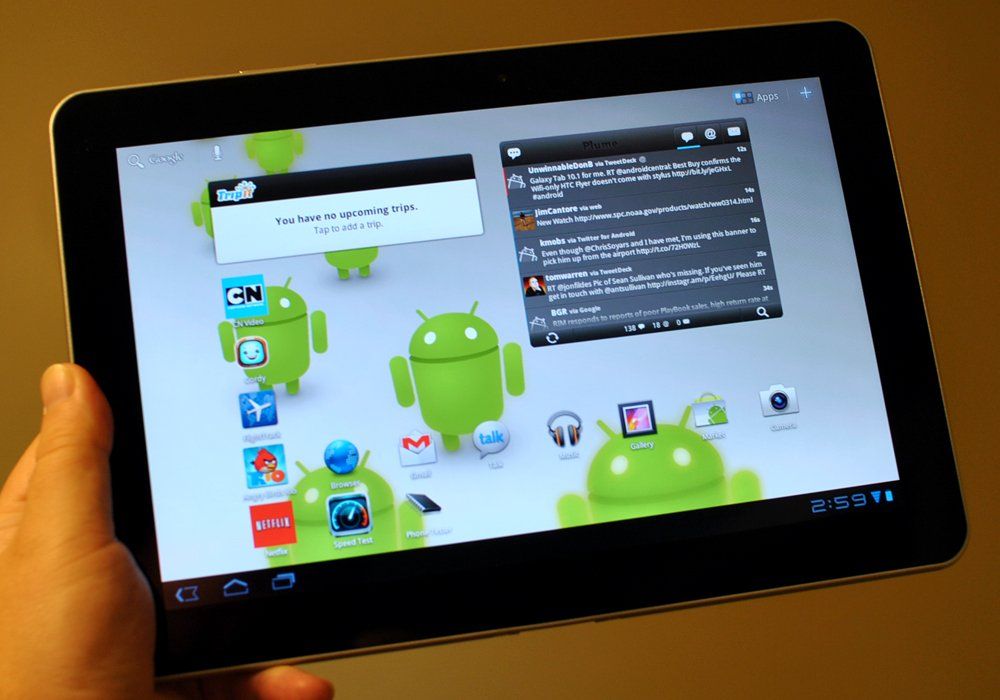
There's kind of no easy way to say this without insulting one of the year's most important pieces of Android tech, so we're just going to come out and say it:
Samsung's Galaxy Tab 10.1 is what Android 3.0 Honeycomb should have launched on.
There. We said it. But it's true. As important as the Motorola Xoom was (and is) to Android and Honeycomb tablets as platforms, it left a bit to be desired in the design department. And so it's almost fitting that Samsung, the company that brought us the 7-inch Galaxy Tab last fall -- basically an oversized Froyo smartphone -- is about to launch a little slice of sexy in the Galaxy Tab 10.1.
But the story's not that simple, is it? Join us after the break as we break down the special edition Galaxy Tab 10.1 handed out at Google IO.
Galaxy Tab 10.1 Specs | Galaxy Tab 10.1 Forums | How to root the Galaxy Tab 10.1
A long, strange trip to the 10.1
Galaxy Tab 10.1 at Mobile World Congress in February 2011
We're not too proud to admit that we've had a slightly confusing time leading up to the current iteration of the Galaxy Tab 10.1. Flash back to mid-February 2011, at Mobile World Congress in Barcelona, Spain, when Samsung first announced the Galaxy Tab 10.1. Thinner and lighter than the Motorola Xoom, which at the time was the only other Honeycomb tablet, we had no problem declaring that "this Galaxy Tab definitely takes Sammy into the next generation of Android tablets." Because it did. (Check out our hands-on with the Galaxy Tab 10.1 at MWC.)
Be an expert in 5 minutes
Get the latest news from Android Central, your trusted companion in the world of Android
But then something happened, just a couple weeks later. The iPad 2 was announced. Not that we didn't all know it was coming, but it made the Xoom look quite beastly, and the Galaxy Tab 10.1, well, a little boring. And stories started to come out that Samsung likely was already looking to revamp the Galaxy Tab 10.1.
The new Galaxy Tab 10.1 at CTIA in March 2011
Enter CTIA 2011, in Orlando, just a couple weeks after the iPad 2 announcement. Samsung not only announced an 8.9-inch tablet, but that the Galaxy 10.1 "went back to the drawing board ... to create the thinnest and lightest large-screen tablet in the industry." The timing is intriguing. There's no way that the revamped Galaxy Tab went from inception to prototype in just a couple weeks -- Samsung must have already had this in the works.
And we got a quick look at the new Galaxy Tab 10.1 -- behind glass.
That brings us the Google IO developer conference in mid-May. On the first day of the event, upon announcing Android 3.1, Google handed out special edition Galaxy Tab 10.1s to everyone at Moscone West. And that's what we present to you now.
The hardware
The Galaxy Tab 10.1 given out at Google IO -- GT-P7510 -- indeed is a special-edition device. The box sports the Google IO logo, and there' s a big "NOT FOR SALE" notice on the bottom. You won't be getting one of these in stores. But you will be getting the same form factor and guts when its goes on sale June 8.

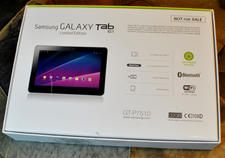
It's thin. It's 8.6mm thin. It's light. 595 grams light. And compared to the Motorola Xoom, it's night and day.

The Galaxy Tab actually is a few millimeters wider and taller than the Xoom. But as is the case these days, that larger size is mitigated by the Tab's thinness. (We saw the same thing in the Samsung Infuse 4G smartphone. Big, but thin.)
The front of the Galaxy Tab is completely smooth. As is the case with Honeycomb tablets, there are no buttons to be seen. The home-menu-back-search buttons have all moved to software. So all you've got is the 10.1-inch screen (at 1280x800 resolution), and a little speck of a 1.3MP front-facing camera. There's no notification light, which is par for the course for Samsung devices now.
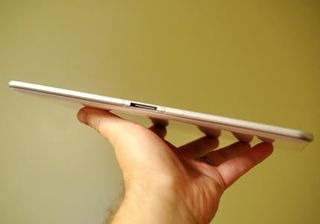
The screen itself is decent enough, but we're quickly starting to want a higher resolution. First-world problems, we know, but individual pixels are readily apparently. That's not a deal-breaker, and it really doesn't take away from an otherwise good experience with the Galaxy Tab. But for otherwise having the form factor nailed, it'd be a feature that would really give it a boost.

The Galaxy Tab has nicely rounded corners, like the Xoom. There are no sharp edges to be found. But the feel is very different. Whereas the Xoom has a metal and soft-touch back, the Galaxy Tab 10.1 is all plastic. (That's another change from the version we first saw at Mobile World Congress, too.) The back of our special edition Tab is done in an Android robot motif, with a silver sliver jutting into it. That's where you'll find the 3.2MP camera and flash.
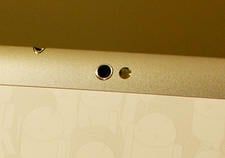
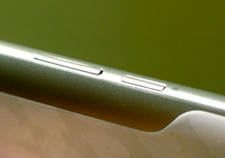
The top bezel houses the 3.5mm headphone jack, power button and volume rocker. We like having the power button on the side (even if most Samsung smartphones now have it on the right-hand bezel). But the volume rocker can take a little getting used to. On the Xoom, it's vertical, on the left-hand bezel. So you press up for volume up, and down for volume down. But when holding the Galaxy Tab in the landscape position, as you'll likely be doing most of the time, the volume rocker is horizontal on the top bezel. So left is volume-down, and right is volume up. That actually coincides with the on-screen volume indicator, which also is horizontal. But after we don't know how many smartphones and tablets we've used with a vertical volume rocker on the side of the device, we're having to retrain our brains a little.
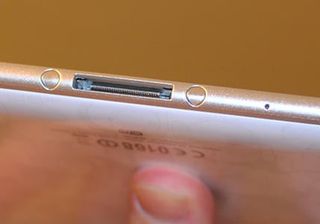
The bottom bezel has the proprietary connector, which you'll use to charge the Galaxy Tab, or connect it to a computer (or, eventually, accessories). The good news is that you don't need a separate cable for charging. The bad news is you need Samsung's rather large plug to charge the thing. Trade-offs.
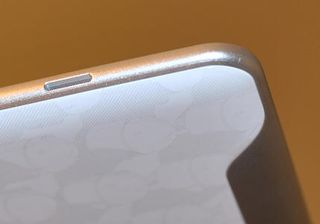
There's a little pinhole microphone down there, as well as a couple of plastic circles covering the screws that hold the whole thing together. Toss in the single speaker on each side bezel -- and the speakers are pretty good, but not as good as on the Xoom -- and that's it for the industrial design.
Samsung hasn't necessarily done anything extraordinary here -- it's your basic tablet design, right? It's got the same basic shape as every other Honeycomb tablet we've used. But it's the little things -- namely the simple, clean lines and thinness -- that stand out in the Galaxy Tab 10.1.
What's under the hood
There's not a whole lot to say here that we haven't said already. The Galaxy Tab 10.1 uses the same architecture as the other Honeycomb tablets we've used thus far -- NVIDIA's Tegra 2 1GHz system on a chip. And it's as speedy as it ever was. Undoubtedly Samsung's done a few tweaks, but we really don't see much of a speed difference over the Xoom, at least not in everyday use.
Our unit here is a 32GB version -- there will be 16GB versions as well. There's no swapable microSD card, which might bother you. Or it might not. We've got 725MB of useable RAM, which is working quite well, thank you very much, and we've got 1GB of program memory. Apps, of course, can be moved to the internal storage should we use that up.
As for battery life, it's got a 7,000mAh power source crammed into that thin form factor, and we're easily getting a day's use out of it. That'll vary if you're watching video, of course. But for basic browsing, Twitter use and e-mail --and some Angry Birds -- you should get a day, easy.
The software
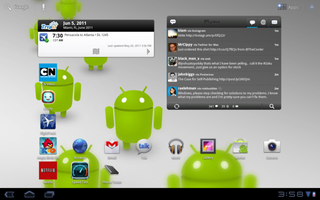
Not a whole lot to say here that hasn't been said already. The Google IO special-edition Galaxy Tab 10.1 runs Android 3.0.1, and it'll be getting an upgrade to Android 3.1, with its suite of new APIs -- and, more important, the ability to stream Google Movies.
Otherwise, you've got a stock Honeycomb experience. No skinning, and only a couple of apps loaded by default, including Samsung's Music Hub and Samsung Apps, Pulse and Quickoffice.
While we've got your attention, though, allow us this brief rant: Netflix needs to open itself the hell up and get on this tablet, ASAP. No ifs, ands or buts. It's the perfect form factor, and the perfect size.
We're not going to worry too much about any bugs on this version of the Galaxy Tab. It's a special edition and clearly labeled as a developer unit. That's the price you pay for a free pre-release tablet, and one we're sure most of you would gladly pay.
The cameras
Funny story about the Google IO edition Galaxy Tab as a camera. It was given out the afternoon of the first day of the conference. That evening, Google threw its big party, with Jane's Addiction performing. And while we're quite used to seeing cell phones up in the air at a concert, it's seeing a couple hundred 10-inch tablets held aloft (with two hands, of course) during the better parts of "Ritual de lo Habitual" was one of the most gloriously geeky things we've experienced.
But we digress. ...
Testing tablet cameras is kind of like eating fast food -- we're left wondering why we did it when it's said and done. In all likelihood, you're not going to be doing a lot of shooting with the rear camera on a 10-inch device. Here's a novel idea -- lose the rear-facing camera and up the quality on the front-facing camera. Want us to start doing more video chatting on a tablet? Give us a little better quality on the front camera. It doesn't even need to be 8MP or anything. Just a little better.
But we digress. ...
Images below open in full size in a new window




The wrap-up
We said it at the outset, and we stand by it still. The (latest) Galaxy Tab 10.1 has the form factor that we wish Honeycomb had debuted on. That's really not a knock against the Motorola Xoom -- something had to be first, and we really don't know what kind of time constraints went into development of the Xoom and the release of Honeycomb.
But Samsung has slimmed down the Galaxy Tab enough, and made it light enough, to make it a much more viable option. And Samsung did us a solid by actually announcing price and availability at CTIA. Come June 8, you'll be able to get the 16GB version for $499, and the 32GB version for $599. No, it's not cheap. But it's in line with the the other 10.1-inch Honeycomb tablets.
What would we change? At this point, not a whole lot. Maybe a keyboard dock like the ASUS EeePad Transformer, but Samsung's well capable of bringing something along those lines.
Point is, the Samsung Galaxy Tab 10.1 deserves your attention.
